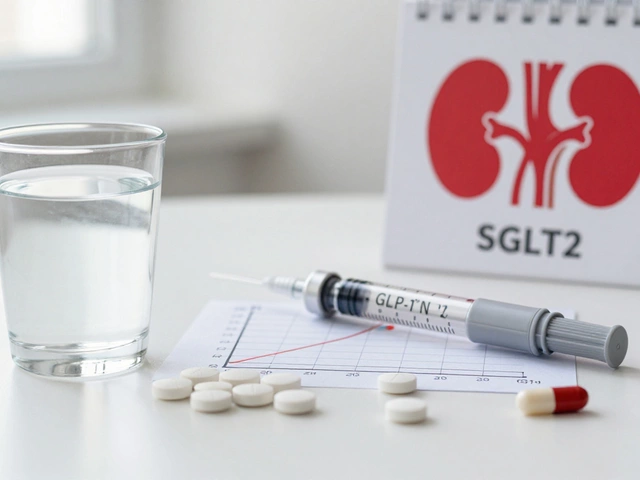Weight-Loss Medication Selector
Enter your information and click "Check Eligibility" to see which weight-loss medications you may qualify for.
Medication Overview
Orlistat
Fat-blocker
Phentermine/Topiramate
Sympathomimetic + Appetite Suppressor
Semaglutide
GLP-1 Receptor Agonist
Tirzepatide
Dual GIP/GLP-1 Agonist
Naltrexone/Bupropion
Reward Pathway Modulator
Liraglutide
GLP-1 Receptor Agonist
When you ask a doctor about shedding pounds, the answer today isn’t just “eat less, move more.” Over the past few years, a growing toolbox of prescription weight‑loss drugs has reshaped the conversation. From older appetite suppressants to the newest GLP‑1 agonists, clinicians now match a medication to your BMI, health history, and lifestyle goals. This guide walks you through the most common prescriptions, how they work, who can use them, and what you should watch out for before you start.
Prescription weight‑loss landscape in 2025
In the UK, the National Institute for Health and Care Excellence (NICE) and the British Obesity and Metabolic Surgery Society (BOMSS) set the rules for when a drug can be reimbursed. Generally, you need a body‑mass index (BMI) of30or higher, or27with a related health condition such as type2 diabetes or hypertension. That threshold has stayed steady, but the range of approved medicines has expanded dramatically.
Most of the drugs you’ll hear about belong to three families:
- Fat‑blocking agents (e.g., Orlistat is a lipase inhibitor that prevents about 30% of dietary fat from being absorbed).
- Appetite‑suppressing sympathomimetics (e.g., Phentermine is a short‑acting stimulant that reduces hunger signals in the brain often combined with Topiramate is an anticonvulsant that also curbs appetite).
- GLP‑1 receptor agonists - a class that mimics an gut hormone to slow gastric emptying and boost satiety (examples include Liraglutide is a once‑daily GLP‑1 agonist originally approved for diabetes, Semaglutide is a once‑weekly GLP‑1 agonist with strong weight‑loss data, and the newer Tirzepatide is a dual GIP/GLP‑1 receptor agonist that has shown up to 20% body‑weight reduction in trials).
Each family brings a different balance of efficacy, side‑effects, dosing convenience, and cost. Below, we break down the most frequently prescribed names you’ll encounter in a GP or specialist clinic.
How the main weight‑loss drugs work
Orlistat
Orlistat works in the gut. By inhibiting pancreatic lipase, it prevents about a third of the fat you eat from being broken down. The undigested fat is expelled in the stool, which can lead to oily spotting or urgent bowel movements if you over‑indulge in fatty foods. Because its action is confined to the digestive tract, it has no direct effect on blood sugar or heart rate.
Phentermine/Topiramate (brand name Qsymia)
Phentermine stimulates the release of norepinephrine, a neurotransmitter that tells the brain you’re full. Topiramate adds a secondary appetite‑blocking effect and can also improve insulin sensitivity. The combination is taken once daily. It carries a boxed warning for increased heart rate and blood pressure, so doctors monitor cardiovascular health closely.
Liraglutide (Saxenda)
Liraglutide is a synthetic version of the gut hormone GLP‑1. It slows gastric emptying, reduces hunger cravings, and modestly improves glucose control. The drug is injected subcutaneously each morning. Common side‑effects include nausea, vomiting, and mild diarrhoea, which usually settle after the first few weeks.
Semaglutide (Wegovy)
Semaglutide is a more potent GLP‑1 agonist that you inject once a week. Clinical trials (STEP1‑4) showed an average 15‑17% body‑weight loss after 68weeks when paired with diet and exercise. Its side‑effect profile mirrors liraglutide but tends to be a bit milder because the dose is spread over a longer interval.
Tirzepatide (Mounjaro-off‑label for weight loss)
Tirzepatide activates both GIP and GLP‑1 receptors, giving it a double‑hit on appetite and metabolic control. In the SURMOUNT‑1 trial, participants lost up to 22% of their initial weight after a year. Though not yet approved in the UK specifically for obesity, many specialist clinics prescribe it off‑label where other options have failed.
Naltrexone/Bupropion (Mysimba)
This combination works on the brain’s reward pathways. Naltrexone blocks opioid receptors that can trigger cravings, while bupropion boosts dopamine and norepinephrine to reduce appetite. It’s taken twice daily and is generally well‑tolerated, though insomnia and dry mouth are common complaints.

Comparison of the most common prescription weight‑loss drugs
| Drug | Mechanism | Typical Dose | Average Weight Loss (12mo) | Common Side‑effects | Approx. UK Cost / month |
|---|---|---|---|---|---|
| Orlistat | Pancreatic lipase inhibitor | 120mg TID with meals | 5‑7% of baseline | Oily stools, flatulence | £15‑£20 |
| Phentermine/Topiramate | Sympathomimetic + appetite suppressant | 7.5mg/46mg daily | 8‑10% | Increased heart rate, dry mouth | £120‑£150 |
| Liraglutide (Saxenda) | GLP‑1 receptor agonist | 3mg subcut. daily | 8‑10% | Nausea, vomiting | £300‑£350 |
| Semaglutide (Wegovy) | GLP‑1 receptor agonist | 2.4mg subcut. weekly | 15‑17% | Nausea, constipation | £600‑£700 |
| Tirzepatide (off‑label) | Dual GIP/GLP‑1 agonist | 5‑15mg weekly | 20‑22% | Nausea, mild pancreatitis risk | £800‑£900 |
| Naltrexone/Bupropion | Reward‑pathway modulator | 32mg/360mg BID | 5‑6% | Insomnia, headache | £150‑£180 |
How to get a prescription: eligibility and the clinical pathway
Getting a weight loss medication isn’t as simple as walking into a pharmacy. Here’s the typical route in England:
- Initial assessment: Your GP measures BMI, reviews blood pressure, cholesterol, glucose, and any comorbidities.
- Lifestyle review: You’ll be asked to document recent diet, activity, and previous weight‑loss attempts. A brief structured diet plan is usually recommended first.
- Eligibility check: If BMI≥30, or BMI≥27 with a related condition, you meet the NICE threshold.
- Discussion of options: The doctor explains pros/cons of each drug, potential side‑effects, and the need for ongoing monitoring.
- Prescribing: If you choose a medication, the GP writes a script. For GLP‑1 agents you may need a referral to an obesity specialist or a Tier2 weight‑management service.
- Follow‑up: Appointments at 4‑6weeks, 3months, and then every 6‑12months to assess weight change, blood work, and any adverse events.
Remember, prescriptions are rarely a “set‑and‑forget” deal. They work best when paired with a calorie‑controlled diet, regular exercise, and behavioural coaching.

Checklist before you start a prescription weight‑loss drug
- Do you meet the BMI or health‑condition criteria?
- Have you tried lifestyle changes for at least three months?
- Are you pregnant, planning pregnancy, or breastfeeding? Most agents are contraindicated.
- Do you have a history of pancreatitis, gallstones, or uncontrolled hypertension?
- Are you on medications that could interact (e.g., warfarin, insulin, certain antidepressants)?
- Can you commit to regular monitoring (blood tests, blood pressure, weight checks)?
- Do you understand the cost‑sharing structure with the NHS or private insurance?
If you answered “yes” to most of these, you’re in a good position to discuss a prescription with your doctor.
What to expect once you start
First‑month side‑effects are common, especially with GLP‑1 agonists. Nausea tends to peak between weeks2‑4 and then eases. Most clinicians start at a low dose and titrate up gradually to improve tolerance. Weight loss is usually gradual: 0.5‑1kg per week with GLP‑1 drugs, slightly slower with Orlistat.
Monitoring includes:
- Weight and BMI every 2‑4weeks for the first 3months.
- HbA1c and fasting glucose if you have pre‑diabetes or diabetes.
- Liver function tests for drugs like Orlistat and combination agents.
- Blood pressure and heart rate for sympathomimetic drugs.
If you plateau or lose less than 5% of your baseline weight after six months, it’s time to reassess - either adjust the dose, switch agents, or intensify lifestyle support.
Frequently Asked Questions
Can anyone get a weight‑loss prescription?
Only people who meet the BMI threshold (≥30, or ≥27 with a weight‑related condition) and have tried lifestyle changes for at least three months are eligible under current NICE guidelines. Exceptions may apply in specialist obesity clinics.
How do GLP‑1 drugs differ from older appetite suppressants?
GLP‑1 agonists act on a gut hormone pathway that slows gastric emptying and reduces hunger, leading to larger, sustained weight loss (often >15% in a year). Older stimulants like phentermine boost heart‑rate and carry higher cardiovascular risk, and the weight loss is generally modest (5‑10%).
Is the weight loss permanent after stopping the medication?
Most drugs only maintain the weight loss while you keep taking them. After discontinuation, appetite often returns to baseline, and many people regain some or all of the lost weight unless they have solid lifestyle habits in place.
What are the biggest safety concerns with semaglutide?
The main issues are gastrointestinal (nausea, constipation) and a rare risk of gallbladder disease. There have been isolated reports of pancreatitis, so doctors screen for a history of pancreatic problems before prescribing.
Can I combine two prescription weight‑loss drugs?
Combining agents is generally discouraged because of overlapping side‑effects and limited evidence of additive benefit. If the first drug isn’t effective, clinicians usually switch to a different class rather than stack them.





